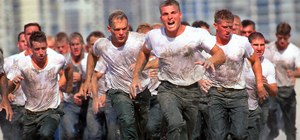These days, not enough emphasis is put on physical fitness when it comes to tennis. It seems that parents are content to paying for private lessons but when the lesson's over, players bag it in (or do some half-hearted effort to perform a couple minutes of fitness drills). The difficult part about tennis is that it's an endeavor that requires skill AND physical fitness. You simply cannot rely on skill alone to get you to the next level. Offense and Defense require either explosiveness, power, endurance, balance and range of motion. As a result, it is imperative that you, as a player, develop a passion for cross-training. Everybody likes to lift trophies but it's usually only those who are willing to get dirty, bloody and sweaty who have the fortune to do so on the biggest stages.
Just like technique, you have to analyze yourself and pin-point your weakness areas. Furthermore, you have to have a good understanding of yourself as a player. For example, are you faster moving to the forehand than the backhand? Are you faster moving forward than backwards? Do you have strong shoulders? Do low balls give you problems? Do you lose long matches because you run out of steam? How do you see yourself as a player? Are you more aggressive? Defensive? Passive? Etc. In other words, you have to develop a game plan for strengthening your problem areas as well as improving the areas that are already above-average.
I see a lot of players who want to improve their physical fitness but do so in a way that is less than optimal. Take for example a player who can be described as a counter-puncher. This player can spend hours in a gym working on his "guns" with little or no running or agility exercises. He simply loves to lift weights. Great! I tend to think that some fitness is better that none at all. However, how does a fitness routine that is focused on weights help a counter-puncher cover the court?! Being stronger WILL help this player; that's a given. But no matter how strong the rabbit, it will not outrun the wolf. Similarly, you can have a serve-and-volleyer who spends hours pounding the treadmill or spinning the bike but who does no sprints or weight-lifting. He does it because he likes it and doesn't have to think about what he's doing (i.e., "no brain no headache"). Again, as long as the player breaks a sweat it's better than lying on the couch. However, how do these routines match-up with the player's on-court needs?!
My recommendation would be to have a fitness routine that is tailored to the person. Obviously, everybody needs to be well-rounded. However, it's important to focus on the fitness components that are utilized in the player's weapons as well on those that cover weaknesses. A proper fitness routine will include weights (for power, explosiveness AND maintenance), cardio (for endurance), sprints (speed) and plyometrics (for agility). With respect to the latter, the jump rope is really the best exercise and not enough players are doing it (or are even capable of doing it). How do you expect to keep your feet moving for 3 sets if you can't do it for 3 minutes? The reality is that when players get exhausted, they tend to fall back on their heels (become flat-footed) making it that much more difficult to cover the court.
And covering the court is the point of tennis. THE NATURAL STATE OF A TENNIS PLAYER IS TO BE IN MOTION! Your racket's strike zone is only about 24 square inches (that's the 4-6 center strings). The rest of the racket is, basically, useless in terms of actually striking the ball. With 24sq inches, you're supposed to strike a ball with a diameter of 2.63 inches moving at 100mph. Oh, did I forget to mention that you have to cover an area (your court) of approximately 21,060 CUBIC feet of space. You're literally trying to hit a fast moving object with a broom-stick and you have to do so while covering an enormous area. If you're just a tad slow, you will either not get there or will get there but you will reacting to the opponent's shot rather than dictating where you want the ball to go.
So supplement your tennis practices with at least one hour of fitness per day. Try to cover all the components (strength, endurance, speed, agility) if you can and you will see a dramatic improvement in your game.
 Saturday, October 15, 2011 at 03:37PM
Saturday, October 15, 2011 at 03:37PM  CAtennis
CAtennis 

